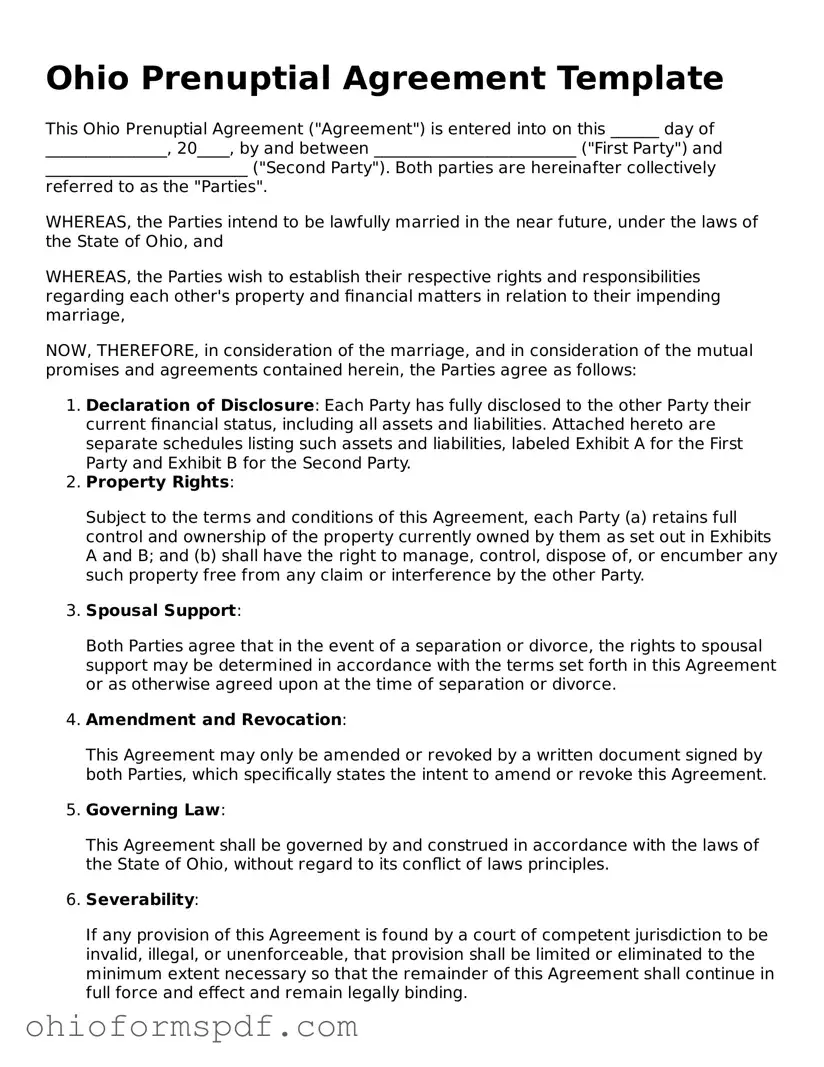What is a Prenuptial Agreement form in Ohio?
A Prenuptial Agreement in Ohio is a legal document that a couple signs before getting married. This agreement outlines how assets and debts will be handled during the marriage and in the event of divorce, separation, or death of one of the spouses. It's designed to protect each person's assets and to ensure a fair distribution according to the couple's wishes, rather than under state law.
Do I need a lawyer to create a Prenuptial Agreement in Ohio?
While it's not legally required to have a lawyer prepare your Prenuptial Agreement in Ohio, it's highly recommended. A lawyer can help ensure that the agreement meets all legal standards, represents both parties fairly, and is enforceable in court if necessary. They can also provide valuable advice on how to address complex financial issues.
Can a Prenuptial Agreement in Ohio cover child support or custody?
No, a Prenuptial Agreement in Ohio cannot dictate terms of child support or custody. These issues are determined by the court based on what is in the best interests of the child at the time of divorce or separation. However, the agreement can cover other financial aspects related to children, such as savings accounts for education.
Is a Prenuptial Agreement in Ohio effective immediately upon signing?
Yes, once both parties sign the Prenuptial Agreement in Ohio, and it's notarized, it becomes effective. However, its provisions typically don't come into play until there is a divorce, separation, or death. It's important that both parties fully understand and agree to the terms before signing.
Can we modify our Prenuptial Agreement after getting married?
Yes, couples can modify their Prenuptial Agreement after their marriage in Ohio. This usually requires both parties to agree to the changes, sign the amendment, and have it notarized, similar to the original agreement. It's advisable to consult with a lawyer to make any modifications.
What happens if we don't sign a Prenuptial Agreement in Ohio?
If you don't sign a Prenuptial Agreement in Ohio and later decide to divorce or one spouse dies, your assets and debts will be divided according to Ohio state law. This might not align with your personal wishes or could result in a less favorable outcome for either spouse.
Are Prenuptial Agreements enforceable in Ohio?
Yes, Prenuptial Agreements are generally enforceable in Ohio, provided they meet certain standards. They must be entered into voluntarily, without fraud, duress, or coercion. Both parties must fully disclose their assets and debts, and the terms must be fair and reasonable at the time of enforcement. A court may refuse to enforce an agreement if it finds that these conditions were not met.
Can Prenuptial Agreements in Ohio protect my business?
Yes, a Prenuptial Agreement can help protect your business in Ohio. It can specify that your business is separate property and detail arrangements for its value and operation in case of divorce or death. This is particularly important for business owners to ensure the continuity and integrity of their business.
How do I know if a Prenuptial Agreement is right for me?
Deciding whether a Prenuptial Agreement is right for you involves considering several factors such as your assets, your partner's assets, your financial goals, and any children from previous relationships. Discussing these topics with your partner and consulting with a legal advisor can help you make an informed decision.
Are there any scenarios where a Prenuptial Agreement might not be a good idea?
In some cases, a Prenuptial Agreement may not be necessary or beneficial. For example, if both partners have similar financial situations and no significant assets or debts coming into the marriage, then the benefits of drafting an agreement might be outweighed by the costs. Additionally, if discussing or negotiating an agreement causes significant relationship strain, it might not be the right choice for your relationship.
